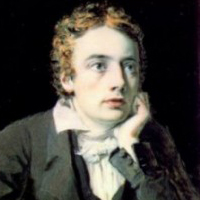Ode on Melancholy by John Keats: Summary and Analysis
The poem Ode on Melancholy embodies one of Keats' greatest insights into the nature of human experience. Here, the two conflicting domains of experience manifest as joy and melancholy. The poem has an abrupt beginning, which reads like a conclusion after a long mental conflict of the speaker. The poem in fact had one stanza before the present first stanza, and so also the present poem begins like a drama of thoughts in medias res; the conflict has brought the speaker to a phase of resolution where he begins by declaring his understanding of the dialectics.

John Keats (1795-1821)
The general idea of the poem is that sadness is to be found not in the ugly and painful things of life, but in the beauty and pleasures of the world. Logically then true happiness would also be found in contemplating the ugly and the painful things. If the pain of the suffering is less acute than the pain of knowing that beauty and joy will soon fade, the pleasure of life is also less intense than the knowledge that it is pain which gives meaning to it. Obviously, Keats seems to be preoccupied with the idea of seeking a heavy dose of melancholy. But, he finds both problem and remedy in the same object. The remedy for melancholy for common people would be something that makes them unconscious of sadness and pain. To experience true melancholy then one must rather stimulate all senses. So purifying the senses is not a way to experience melancholy. A More acute senses and more consciousness can only make us experience true melancholy and tragedies of life.
In the second stanza, Keats has suggested all sensuous techniques for experience: "glut thy sorrow" for the gustatory (taste), "imprison her soft hand" for the tactile (touch), "let her rave" for the aural (hearing), "thy missess some rich anger shows" for the visual and "morning rose" for connotation of the olfactory (smelling) perception. In this way, he has suggested the reader to seek ‘sensuous’ stimulants of joy to realize how all these objects of pleasure lead us naturally into the anguish of the 'soul' through the tragic consciousness of their transience. This is a principle of reaching at the true experience of melancholy via the opposite. This is, no surprise, the principle of human cognition: light and dark, vice and virtue, life and death, all get their meaning against their opposites. The originality in Keats‘conception lies in this ‘simultaneity’ of perception.
True melancholy is inseparable from consciousness and contemplation of beautiful things and the experience of joy and pleasure. Only that person can experience the finest shades of melancholy who has the capacity for enjoying the raptures of delights, and the ecstasies of joy. But, melancholy comes to the person who knows that the raptures and ecstasies of the beautiful and pleasurable are tragically short lived. A dull and blunt soul incapable of experiencing the intensity of pleasure cannot also experience acute pain. So, the sharpness of consciousness resolves pain and pleasure in the act of contemplation of either of them.
In the last stanza, Keats personifies the state of melancholic mind as, goddess. He characterizes her by describing the company that she keeps: Beauty, Joy and Pleasure. This cheerful trio is an unusual company for the somber Melancholy. But, each of them has within itself the seeds of its opposites that can be summed up as melancholy. The expert of experience, who is sensitive and insightful enough, only can understand that even joy itself is another facet of sorrow. The knowledge of the whole transcends ignorant pleasures or simple oblivion. The choice lies between oblivion and awareness. Though pain is the price of awareness, what makes the pain bearable in Keats' view is his implied affirmative that experience itself both of the pleasant and the painful alike is valuable. Experience itself is to be savored for its own sake. The reality of life, which it is made up of such inextricable opposites, is to be favored above a one-sided quest for temporary pleasure, oblivion or masochistic search for melancholy. The person who can experience the intensity of joy can experience melancholy, and vice versa.
Melancholy and joy, in the normal sense, is conflicting phenomena. These phenomena do seem to have made Keats puzzled over them. Life seems to have perplexed him with its stock of melancholy. Keats finds the solution in his own principle of binaries, where typically the binaries resolve when he propounds the idea of simultaneous understanding, experience and acceptance of the opposites as making the complete whole of reality.
Cite this Page!
Shrestha, Roma. "Ode on Melancholy by John Keats: Summary and Analysis." BachelorandMaster, 2 Aug. 2017, bachelorandmaster.com/britishandamericanpoetry/ode-on-melancholy.html.
Related Topics
Ode to Autumn: Summary and Analysis
Ode on a Grecian Urn: Summary and Analysis
Ode to a Nightingale: Summary and Analysis
Ode to Psyche: Summary and Analysis
Endymion: Summary and Analysis
The Eve of St. Agnes: Summary and Analysis
Bright Star: Summary and Analysis
Le Belle Dame Sans Merci: Analysis
On First Looking into Chapman's Homer: Analysis
The Terror of Death (When I have Fears): Analysis
 |
bachelorandmaster.com |